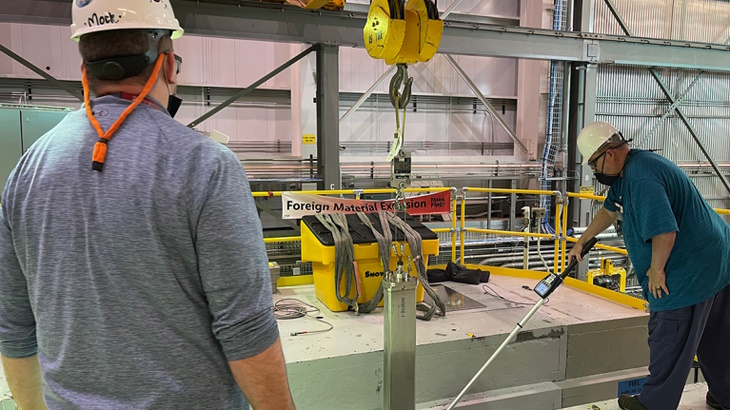A research programme into the safety of fast reactor fuel that has been suspended since the 1990s will resume with tests due to begin at Idaho National Laboratory (INL) next month.

An experiment in the experiment in Broad Use Specimen Transient Experiment Rig (BUSTER) is loaded into TREAT (Image: INL)
Researchers at INL have developed a special capsule to house the experiments, which will use the lab's Transient Reactor Test (TREAT) facility to mimic the conditions of fast reactors during postulated accident conditions.
Repurposed fresh legacy fuel pins from INL's former EBR-II reactor - which ceased operations in 1994 - was used for experimental commissioning tests. The researchers will now move on to transient experiments on high-burnup materials archived from historic irradiation testing in EBR-II, including tests on mixed oxide fuel used by Japanese and French fast reactor designs, and metallic alloy fuel used by the USA.
The experiments are part of a four-year cost-shared facility sharing initiative between the US Department of Energy (DOE) and Japan Atomic Energy Agency (JAEA) under the bilateral Civil Nuclear Energy Research and Development Working Group , which was established in 2014. But they also represent the completion of work to test high-burnup fast reactor fuels which began in the late 1980s and came to a stop in 1994, when EBR-II operated for the last time.
Work is now under way to load the first of four irradiated fuel experiments into TREAT, with the first transient test expected to start in February. The first three DOE/JAEA fuel experiments are expected to be completed "by early spring", with the US testing completed before the end of 2024.
During 30 years of operations beginning in 1964, EBR-II - a 62.5 MWth, 20 MWe liquid-sodium cooled, fast breeder reactor - was used to test fuels and materials as well as being a demonstration fast reactor. It has now been decommissioned, although its iconic dome containment structure remains.
TREAT is one of only a few facilities in the world that is capable of producing bursts of energy that are several times more powerful than conditions found in a commercial reactor, known as transients, which can be used to study fuel performance under extreme conditions. TREAT was placed on standby the same year that EBR-II closed, but was brought back into operation in 2017.
Daniel Wachs, national technical director for the US Advanced Fuels Campaign, said the unique experiments are represent an important step towards developing global confidence in the enhanced performance and safety of advanced nuclear reactor technologies. "It's also a remarkable example of how critical international collaborations will enable the next generation of energy technology development," he added.
Researched and written by World Nuclear News